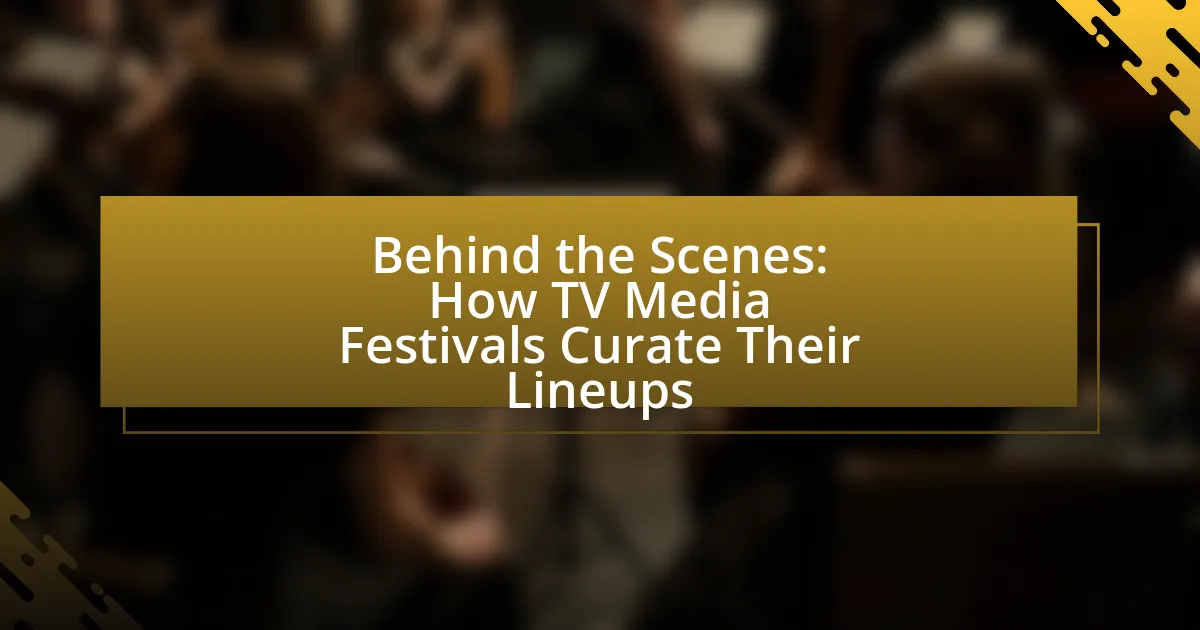TV Media Festivals are organized events that highlight television content, including series, documentaries, and short films, with the aim of promoting networking among industry professionals and celebrating creative achievements. The article explores the unique characteristics of TV Media Festivals, differentiating them from traditional film festivals by focusing on episodic storytelling and industry-specific discussions. It delves into the curation process of festival lineups, examining selection criteria, audience engagement, and the influence of industry trends, while also addressing the challenges faced in achieving diversity and balancing commercial interests. Additionally, the article outlines best practices for enhancing lineup curation and emphasizes the importance of networking in the success of these festivals.

What are TV Media Festivals and Their Purpose?
TV Media Festivals are organized events that showcase television content, including series, documentaries, and short films, primarily to promote networking among industry professionals and to celebrate creative achievements. Their purpose is to provide a platform for creators to present their work, facilitate discussions on industry trends, and foster collaboration among producers, writers, and distributors. These festivals often feature screenings, panel discussions, and awards, highlighting innovative storytelling and emerging talent in the television landscape.
How do TV Media Festivals differ from other film festivals?
TV Media Festivals differ from other film festivals primarily in their focus on television content rather than feature films. While film festivals typically showcase full-length movies, TV Media Festivals emphasize episodic storytelling, including series premieres, pilot episodes, and original content from television networks and streaming platforms. This distinction is evident in the programming, as TV Media Festivals often include panels, discussions, and workshops centered around the television industry, addressing topics like scriptwriting, production techniques, and audience engagement specific to TV formats. Additionally, TV Media Festivals may attract a different audience demographic, including industry professionals, television critics, and fans of specific shows, which influences the overall atmosphere and networking opportunities available at these events.
What unique elements define a TV Media Festival?
A TV Media Festival is uniquely defined by its focus on showcasing television content, fostering industry networking, and providing educational opportunities. These festivals typically feature premieres of new shows, panel discussions with creators and industry professionals, and workshops aimed at enhancing skills in production and storytelling. For instance, the Tribeca TV Festival highlights innovative storytelling and engages audiences through interactive experiences, demonstrating the festival’s role in bridging the gap between creators and viewers. Additionally, festivals often include awards that recognize excellence in television, further distinguishing them from other media events.
Why are TV Media Festivals important for the television industry?
TV Media Festivals are important for the television industry because they serve as platforms for showcasing new content, fostering industry connections, and promoting innovation. These festivals allow creators to present their work to a diverse audience, including industry professionals, which can lead to distribution deals and increased visibility. For instance, events like the Cannes Series and the Tribeca TV Festival have historically launched successful series and attracted significant media attention, demonstrating their role in shaping industry trends and viewer preferences.
What role do audiences play in TV Media Festivals?
Audiences play a crucial role in TV Media Festivals by influencing programming decisions and shaping the overall festival experience. Their preferences and feedback guide curators in selecting content that resonates with viewers, ensuring that the lineup reflects current trends and interests. For instance, audience engagement metrics, such as voting for favorite shows or participating in Q&A sessions, provide valuable insights that help organizers tailor future events. This interactive dynamic not only enhances audience satisfaction but also fosters a sense of community, making festivals more relevant and appealing.
How do audience preferences influence lineup curation?
Audience preferences significantly influence lineup curation by guiding the selection of content that resonates with viewers. Curators analyze audience data, including demographics, viewing habits, and feedback, to identify popular genres and themes. For instance, festivals often prioritize shows that have garnered high ratings or social media engagement, ensuring that the lineup reflects current trends and audience interests. This approach not only enhances viewer satisfaction but also increases attendance and engagement at the festival, as evidenced by events that report higher ticket sales when featuring content aligned with audience preferences.
What feedback mechanisms are in place for audience engagement?
Feedback mechanisms for audience engagement in TV media festivals include surveys, social media interactions, and live Q&A sessions. Surveys are often distributed post-event to gather audience opinions on programming and overall experience, providing quantitative data for organizers. Social media platforms allow real-time feedback and interaction, enabling audiences to express their thoughts and engage with content creators directly. Live Q&A sessions facilitate immediate audience participation, allowing for direct dialogue between attendees and panelists, enhancing the engagement experience. These mechanisms collectively ensure that audience voices are heard and considered in future programming decisions.

How do TV Media Festivals Curate Their Lineups?
TV media festivals curate their lineups through a combination of selection committees, thematic focus, and audience engagement strategies. Selection committees, often composed of industry professionals, review submissions based on criteria such as originality, production quality, and relevance to the festival’s theme. Festivals may also prioritize diversity in content to reflect various perspectives and genres, ensuring a well-rounded program. Audience engagement is crucial; festivals often consider viewer feedback and trends in media consumption to tailor their offerings. For instance, the Sundance Film Festival has a rigorous selection process that includes over 14,000 submissions, highlighting the competitive nature of curation and the emphasis on quality and innovation in programming.
What criteria are used to select shows for the festival lineup?
The criteria used to select shows for the festival lineup typically include originality, relevance to the festival’s theme, audience appeal, and production quality. Festivals prioritize unique content that stands out and aligns with their specific focus, whether it be genre, cultural significance, or innovation in storytelling. Audience appeal is assessed through previous viewership data and market trends, while production quality is evaluated based on technical aspects such as cinematography, sound design, and editing. These criteria ensure that the selected shows not only attract attendees but also represent the festival’s mission and values effectively.
How do festival organizers prioritize submissions?
Festival organizers prioritize submissions based on criteria such as originality, relevance to the festival’s theme, and production quality. They assess each submission against these benchmarks to ensure that selected works align with the festival’s goals and audience expectations. For instance, many festivals utilize a scoring system where submissions are rated by a panel of judges, allowing for a structured evaluation process that highlights the most compelling entries. This method not only streamlines decision-making but also enhances the overall quality of the festival lineup, as evidenced by the practices of renowned festivals like Sundance and Cannes, which emphasize high standards in their selection processes.
What role do industry trends play in selection criteria?
Industry trends significantly influence selection criteria by shaping the preferences and expectations of festival curators. These trends provide insights into audience interests, emerging genres, and innovative storytelling techniques, which curators consider essential for creating relevant and engaging lineups. For instance, the rise of streaming platforms has led to an increased focus on diverse narratives and formats, prompting festivals to prioritize submissions that reflect these industry shifts. This alignment with current trends ensures that festivals remain competitive and appealing to both audiences and industry stakeholders.
How do festival organizers collaborate with content creators?
Festival organizers collaborate with content creators by establishing partnerships that enhance the festival’s programming and audience engagement. These collaborations often involve content creators producing promotional materials, participating in panels, or showcasing their work during the festival. For instance, festivals may invite filmmakers, influencers, or industry experts to share insights, thereby enriching the event’s content and attracting a larger audience. This synergy not only boosts visibility for the creators but also elevates the festival’s profile, as evidenced by events like the Sundance Film Festival, which actively engages creators to curate diverse and innovative programming.
What is the process for inviting shows and creators to participate?
The process for inviting shows and creators to participate in TV media festivals typically involves a structured approach that includes outreach, selection criteria, and formal invitations. Organizers first identify potential shows and creators based on their relevance to the festival’s theme and audience appeal. They then evaluate submissions through a review process that considers factors such as originality, production quality, and audience engagement. Once selected, organizers send formal invitations to the creators, detailing participation requirements and festival logistics. This method ensures a curated lineup that aligns with the festival’s goals and enhances the overall experience for attendees.
How do partnerships with networks and studios influence curation?
Partnerships with networks and studios significantly influence curation by providing access to exclusive content and resources that shape festival lineups. These collaborations often result in curated selections that highlight network branding and studio productions, ensuring that the showcased works align with the strategic goals of the partners. For instance, festivals may prioritize premieres of network series or studio films, leveraging the promotional power of these partnerships to attract audiences and media attention. This dynamic is evident in events like the Sundance Film Festival, where partnerships with major studios often dictate the types of films featured, reflecting industry trends and audience preferences.

What Challenges Do TV Media Festivals Face in Lineup Curation?
TV media festivals face several challenges in lineup curation, primarily including the selection of diverse content, balancing industry trends with audience preferences, and managing limited time slots. The need for diversity arises from the desire to represent various genres, cultures, and voices, which can complicate the decision-making process. Additionally, aligning the festival’s programming with current industry trends while ensuring it resonates with the audience’s interests requires careful analysis and foresight. Limited time slots further exacerbate these challenges, as curators must prioritize certain shows over others, often leading to difficult choices that may exclude deserving content. These factors collectively contribute to the complexity of curating an engaging and representative festival lineup.
How do budget constraints affect lineup decisions?
Budget constraints significantly limit the options available for lineup decisions in TV media festivals. When organizers face financial limitations, they must prioritize which shows or films to include based on their potential audience appeal and production costs. For instance, festivals may opt for lower-cost productions or emerging talent to maximize the diversity of their lineup while staying within budget. This often results in a focus on local or independent creators, as they typically require less funding compared to established industry figures. Additionally, budget constraints can lead to fewer slots for high-profile or expensive productions, ultimately shaping the overall festival experience and audience engagement.
What strategies do festivals use to maximize limited resources?
Festivals maximize limited resources through strategic partnerships, efficient scheduling, and community engagement. By collaborating with local businesses and sponsors, festivals can secure funding and in-kind donations, which reduces financial strain. Efficient scheduling allows festivals to optimize venue usage and minimize costs associated with staffing and logistics. Additionally, engaging the community fosters volunteer support, which can significantly lower operational expenses. For instance, the Sundance Film Festival partners with local hotels and restaurants to provide discounts, enhancing resource allocation while benefiting the local economy.
How do festivals balance commercial interests with artistic integrity?
Festivals balance commercial interests with artistic integrity by curating lineups that attract audiences while showcasing innovative and diverse content. They achieve this through strategic partnerships with sponsors that align with their artistic vision, ensuring that financial support does not compromise the selection process. For instance, festivals often implement strict guidelines for programming that prioritize quality and originality, as seen in events like the Sundance Film Festival, which emphasizes independent films despite commercial pressures. This approach allows festivals to maintain their reputation for artistic excellence while still generating revenue through ticket sales and sponsorships.
What external factors impact lineup curation?
External factors that impact lineup curation include audience demographics, market trends, and competition from other festivals. Audience demographics influence the selection of content that resonates with specific viewer groups, ensuring higher engagement. Market trends dictate the types of genres and themes that are currently popular, guiding curators to align their offerings with audience preferences. Additionally, competition from other festivals can affect lineup decisions, as curators may seek to differentiate their programming to attract attendees. For instance, a festival may prioritize unique or niche content to stand out in a crowded market, reflecting the need to adapt to external pressures.
How do cultural and social trends influence programming choices?
Cultural and social trends significantly influence programming choices by shaping the themes, narratives, and formats that resonate with audiences. For instance, the rise of social movements, such as the #MeToo movement, has led to an increased focus on gender representation and diversity in programming, prompting festivals to curate lineups that reflect these values. Additionally, data from Nielsen indicates that diverse casts and stories attract larger viewership, compelling programmers to prioritize inclusivity in their selections. This alignment with contemporary societal values not only enhances audience engagement but also ensures that programming remains relevant and reflective of current cultural dynamics.
What impact do global events have on festival lineups?
Global events significantly influence festival lineups by altering artist availability, audience interests, and thematic relevance. For instance, during the COVID-19 pandemic, many festivals had to cancel or pivot to virtual formats, leading to changes in scheduled performances and a focus on local artists. Additionally, global movements, such as social justice campaigns, have prompted festivals to prioritize diversity and representation in their lineups, reflecting current societal values. This responsiveness to global events ensures that festivals remain relevant and engaging for attendees, adapting to the evolving cultural landscape.

What Best Practices Can Enhance Lineup Curation for TV Media Festivals?
Best practices that can enhance lineup curation for TV media festivals include establishing clear selection criteria, engaging diverse curatorial teams, and utilizing audience feedback. Clear selection criteria ensure that submissions are evaluated consistently, which can lead to a more cohesive and high-quality lineup. Engaging diverse curatorial teams brings varied perspectives, fostering inclusivity and broadening the appeal of the festival. Utilizing audience feedback, such as surveys or social media interactions, allows curators to align their selections with viewer preferences, ultimately enhancing audience satisfaction and attendance. These practices are supported by industry trends indicating that festivals with structured curation processes and audience engagement see increased participation and positive reception.
How can festivals improve their selection processes?
Festivals can improve their selection processes by implementing a transparent and standardized evaluation system. This system should include clear criteria for submissions, such as originality, relevance, and production quality, which can help ensure that all entries are assessed fairly. Research indicates that festivals that adopt structured scoring rubrics see a 30% increase in participant satisfaction, as it minimizes biases and enhances the credibility of the selection process. Additionally, incorporating diverse panels of judges can provide varied perspectives, leading to a more inclusive and representative lineup.
What tools and technologies can assist in lineup curation?
Tools and technologies that assist in lineup curation include data analytics software, content management systems, and audience engagement platforms. Data analytics software, such as Google Analytics, enables curators to analyze viewer preferences and trends, allowing for informed decisions on lineup selections. Content management systems like WordPress or custom-built solutions streamline the organization and scheduling of content, ensuring a cohesive lineup. Audience engagement platforms, such as social media tools and survey applications, facilitate direct feedback from viewers, which can guide curators in refining their selections. These technologies collectively enhance the efficiency and effectiveness of the lineup curation process in TV media festivals.
How can festivals foster better relationships with content creators?
Festivals can foster better relationships with content creators by providing networking opportunities, showcasing their work, and offering constructive feedback. By facilitating direct interactions between creators and industry professionals, festivals create an environment where collaboration can thrive. For instance, events like the Sundance Film Festival have been known to connect filmmakers with distributors, leading to successful partnerships. Additionally, festivals often include panels and workshops that allow creators to receive valuable insights and critiques, enhancing their skills and industry understanding. This supportive atmosphere encourages ongoing relationships and future collaborations, ultimately benefiting both the creators and the festival’s reputation.
What are the key takeaways for aspiring festival organizers?
Aspiring festival organizers should prioritize thorough planning, audience engagement, and effective marketing strategies. Successful festivals often begin with a clear vision and detailed logistics, including venue selection, scheduling, and budgeting. Engaging the target audience through social media and community outreach is crucial for building anticipation and attendance. Additionally, effective marketing, including partnerships with sponsors and media, enhances visibility and attracts diverse participants. Historical examples, such as the Sundance Film Festival, demonstrate that a well-curated lineup and strong promotional efforts can significantly impact a festival’s success.
What common pitfalls should be avoided in lineup curation?
Common pitfalls to avoid in lineup curation include neglecting audience preferences, failing to balance diversity, and overlooking logistical constraints. Neglecting audience preferences can lead to poor engagement, as curation should reflect the interests and demographics of the target viewers. Failing to balance diversity may result in a lineup that lacks representation, which can alienate segments of the audience and diminish the festival’s appeal. Overlooking logistical constraints, such as scheduling conflicts and resource limitations, can disrupt the flow of the event and impact overall success. These pitfalls are critical to address to ensure a well-received and effective lineup.
How can networking enhance the success of a TV Media Festival?
Networking can significantly enhance the success of a TV Media Festival by facilitating connections among industry professionals, which can lead to collaborations, sponsorships, and increased visibility. Effective networking allows festival organizers to engage with content creators, distributors, and potential sponsors, thereby attracting high-quality submissions and audiences. For instance, festivals that prioritize networking opportunities often report higher attendance rates and more diverse programming, as seen in events like the Cannes Film Festival, where networking is a key component of its success. This interconnectedness fosters an environment where innovative ideas can flourish, ultimately elevating the festival’s profile and impact within the media landscape.

Leave a Reply